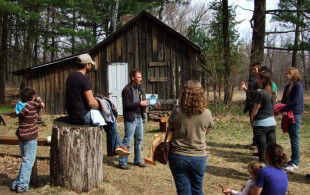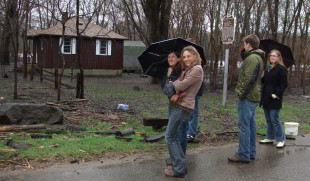Recent Undergraduate Courses
-
American Poetry of the 21st Century (upper-level course)
The special issue of the journal Contemporary Literature (52:4, Winter 2011) edited by Michael Davidson and devoted to American poetry of the first decade of the 21st century was a foundational text for this course, guiding the selection of volumes of poetry we studied and providing examples of current literary criticism in the field of contemporary poetry studies. Students practiced skills of close reading adapted to varied poetics, while developing an understanding of poetry that is bound to cultural and historical contexts.
-
Freshman Course on Literature and the Environment
The environmental crises we now face are consequences not just of industrial development, world population growth, or the consumption of resources fostered by globalized capitalism, but perhaps more fundamentally of the ways in which people in the industrialized nations have thought about the natural environment and their relation to it. One way to get access to that thinking is through works of literature. This course explores how some American writers have conceptualized nature or the wilderness and humans’ relation to the natural world so that we can consider the consequences of those ways of thinking and of the behaviors that have followed from them.

Students on a recent field trip to the Aldo Leopold Shack. The course readings—fascinating works of prose fiction, poetry, and literary nonfiction, mostly from the 20th and 21st centuries—fall into two parts organized around two broad issues: ideas of nature and representations of environmental toxicity. We begin by reading an a few essays challenging people to think critically about the ways in which Americans have traditionally thought about nature. With those critiques in mind, we examine some works of literature that represent experiences in “nature,” including two works from the 19th century (selections from Henry David Thoreau’s Walden and Sarah Orne Jewett’s “The White Heron”) as well as mid- and late-20th century works by William Faulkner, Aldo Leopold, and others. Ceremony, by Native American novelist Leslie Marmon Silko, provides a bridge between the two parts of the course, since it not only explores the clash between tribal understandings of nature and place and those of the dominant U.S. society, but also introduces the problems of toxicity associated with the mining of uranium for bombs and nuclear power. Nuclear waste and radiation poisoning are concerns of several of the quite recent works studied in the second half of the course, which examines literary representations of some kinds of toxicity that have resulted from human interactions with the environment. Narratives representing the damage to environmental and human health associated with industrialized agriculture and contemporary means of food production constitute the final course texts.
The other two courses in the FIG (Freshman Interest Group) are well matched with this small class to provide lots of interesting overlap. Environmental Studies 113: The Humanistic Perspective also explores changing ideas about nature in order to understand the roots of environmental dilemmas we face, but does so through case studies of selected environmental conflicts. Botany/Environmental Sciences 260: Introductory Ecology brings a scientific perspective to related environmental issues.
-
“The Wild, the Threatened, and the Toxic” (large introductory lecture course)
I also teach a large introductory lecture course which is quite similar to the course for freshman described above. Book length readings for this course in a recent offering included Aldo Leopold’s A Sand County Almanac, Leslie Marmon Silko’s Ceremony, Ruth Ozeki’s My Year of Meats, Ann Pancake’s Strange as This Weather Has Been, John D’Agata’s About a Mountain, and Margaret Atwood’s Oryx and Crake. Shorter readings include works by William Cronon, Wendell Berry, Ed Roberson, Lucille Clifton, Rachel Carson, Elizabeth Kolbert, Val Plumwood, and others.
-
Introduction to Modern Literature: Violence and the American Psyche (large lecture course)
We would like to think of events like the recent torture of Iraqi prisoners by Americans in Abu Ghraib as aberrations, uncharacteristic of a people who are fair minded, peaceable, and committed to the principles of human rights. In fact, however, American history is riven with violence, much of which violates the stated principles with which the nation identifies. In this introductory course on American literature written since World War I, we will examine works in varied genres that attempt to confront violence in American history and violence in the American psyche. These novels, poems, and plays do more than expose that violence; they offer implicit analyses of its causes, suggestions for healing its wounds, and models for more peaceful and harmonious ways of living.
We begin the course with works that examine recent violent incidents: an essay on the Abu Ghraib photos and a play focused on the Matthew Shepard murder. These works introduce a number of issues we will encounter in the course and will locate the course theme within the contemporary United States. We then look back in history via study of twentieth-century literary representations of the violence of American slavery and of slavery’s legacies. We next consider literature that addresses forms of violence associated with the movement of white settlers west, especially their relations with Native Americans, and the violence linked with national myths of the wild west, along with a work that considers corporate violence against American workers. The course closes with works (one of them by a Canadian) that highlight forms of violence associated with the increasingly globalized “American dream” of material prosperity and technological advancement.
This 4-credit course enables students to satisfy their Communications B requirement while fulfilling one of their literature requirements. In the discussion sections (two meetings each week), students will have opportunities to respond to lectures, present their own interpretations of the assigned texts, respond to their classmates’ ideas, and develop their writing skills in varied writing assignments. Substantial class time in section meetings will be devoted to learning the conventions of writing about literature and, more generally, of writing persuasive prose. Lectures and discussion sections will emphasize the development of close reading skills while also stressing the importance of social and historical contexts to meaningful literary interpretation.
Recent Graduate Courses
-
American Poetry Since 1950
Through representative volumes, this course attempts to survey major trends and movements in American poetry since 1950. (As the years pass, achieving a genuine survey of this varied scene in fifteen weeks becomes less and less possible.) Because the 1960s were years of particularly notable upheaval, invention, and renewal in the poetry scene, and because the innovations–-as well as the schisms–of that era have had lasting effects, course readings will generally be organized around figures who represent significant trends or schools of poetry that emerged between the mid-1950s and the early 1970s. These include beat, confessional, deep image, Black Mountain, New York school, and Black Arts poetry. Along-side key volumes representing these and other developments, we will read more recent volumes by later poets who can be seen as carrying on and complicating the legacy of the earlier writers/movements. Assigned non-poetic readings–-including manifestoes, statements of poetics, and critical essays–-will help students place the work of individual poets within broader literary, historical, and cultural contexts. These selections will also acquaint students with current issues and methodologies as well as important voices in the field of contemporary poetry studies.
-
North American Poetry and Ecocriticism

Graduate students on field trip to Lorine Niedecker Cabin, Blackhawk Island, Wisconsin Most environmental criticism concerning poetry has focused on “nature poetry” in the Romantic tradition. Course readings will begin with some late 20th C. works extending the Romantic tradition as we analyze assumptions about nature, wilderness, urban environments, and environmentalism that are bound up with conventions of the personal lyric, the pastoral, and the sublime that inform such writing. Most of the course, however, explores work “written under the sign of poetry” (Lyn Hejinian’s phrase) that seeks alternative approaches to ecopoetics and changed perspectives on nature in order to address current environmental issues of the Anthropocene. Reading more experimental volumes by U.S. and Canadian poets, we investigate how contemporary exploratory poetics encode or support environmental understandings suited to the present moment and the challenges it poses: understandings of nature and the wild; of place and belonging in a globalized world; of human relations to nonhuman animals; of toxic chemicals in the environment and bodily vulnerability; of risk; of mass extinction; of extraction industries; of climate change, and more. We will study a volume of poetry a week. Required readings also include environmental theory from several fields and literary criticism or theory by major ecocritics.
-
CHE Interdisciplinary Methods Seminar
Typically offered each spring, the CHE Methods seminar is one of the most important curricular offerings of the Nelson Institute’s Center for Culture, History, and Environment. It has several goals:
- It introduces graduate students from a wide array of departments and programs to different disciplinary and interdisciplinary methods for studying past environmental change and the human cultural contexts within which it occurs.
- It explores the disparate forms of evidence that can be used to reconstruct past environmental change and its human meanings.
- It strives to build a strong sense of community among graduate students and faculty members at UW-Madison who share an interest in past environmental change by creating a place within which grad students from different departments and programs can work together and become colleagues while getting to know faculty members associated with CHE.
Assignments for the seminar are designed to cultivate research skill and methods and to help orient students to the theme of the CHE Place-Based Workshop, a field trip that occurs each May at the end of the spring semester.
Reading and Discussing Poetry
For those interested in seeing an example of how I read and speak about poetry, here are a few videos from a symposium hosted by the Texas Institute for Literary and Textual Studies (TILTS) at the University of Texas-Austin in 2012. You can see video of me reading a poem by Sappho at a reading of works in translation below.
Here’s video of me reading “WING/SPAN/SCREW/CLUSTER (AVES)”, a poem from Evelyn Reilly‘s book Styrofoam:
Below you can see my presentation on that Evelyn Reilly poem for the symposium’s scholar’s roundtable on formalism: